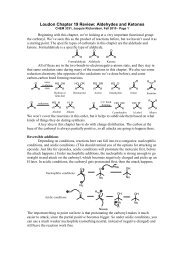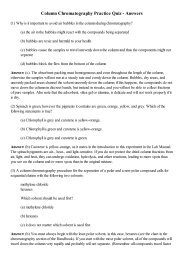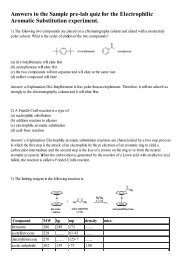7 - Isolation of Limonene.pdf
7 - Isolation of Limonene.pdf
7 - Isolation of Limonene.pdf
You also want an ePaper? Increase the reach of your titles
YUMPU automatically turns print PDFs into web optimized ePapers that Google loves.
Experiment 7: <strong>Isolation</strong> <strong>of</strong> <strong>Limonene</strong><br />
water easily by removing remove the thermometer and thermometer adapter, and pouring water in<br />
through the y-adaptor.<br />
As the distillation proceeds, you should notice an upper layer <strong>of</strong> limonene forming in the 10 mL<br />
graduated cylinder. When the graduated cylinder is close to full, remove this layer with a Pasteur pipet<br />
and put it into a clean, tared vial. Pour <strong>of</strong>f the remaining water into a beaker and set it aside; return the<br />
graduated cylinder to its place and continue distilling. Continue this process until there are about 45<br />
minutes left in the lab period.<br />
In the vial you may notice some droplets <strong>of</strong> immiscible water underneath your limonene layer, if you<br />
accidentally transferred some water to the vial along with your product. In this case, you can dry the<br />
limonene by adding a very small amount <strong>of</strong> sodium sulfate and then pipetting it to a new clean, tared<br />
vial.<br />
Find the mass <strong>of</strong> the isolated limonene and obtain an IR spectrum. Pool your sample with the other<br />
students in the class and measure the optical rotation <strong>of</strong> the sample in ethanol using the polarimeter. If<br />
there is a large amount <strong>of</strong> water in the class pool <strong>of</strong> limonene, a separatory funnel may be useful to<br />
separate the layers.<br />
Wastes<br />
Place excess pulp into the containers marked “Waste Pulp”. Do not pour pulp into the sink. Place any<br />
excess limonene and ethanol (from the polarimetry) in the recovery bottle in the main hood.<br />
Study Questions<br />
1) (+)-<strong>Limonene</strong> is the (R)-enantiomer. Draw the structure <strong>of</strong> this enantiomer indicating the proper<br />
stereochemistry at the stereocenter <strong>of</strong> the molecule.<br />
2) If you isolate 5 g <strong>of</strong> limonene and place it in a total volume <strong>of</strong> 35 mL:<br />
a) What would be the observed rotation, α?<br />
b) If the 5 g <strong>of</strong> limonene was actually not pure, what effect would this have on the<br />
observed rotation?<br />
3) What are the major diagnostic IR bands that you would expect to see in limonene?<br />
41













